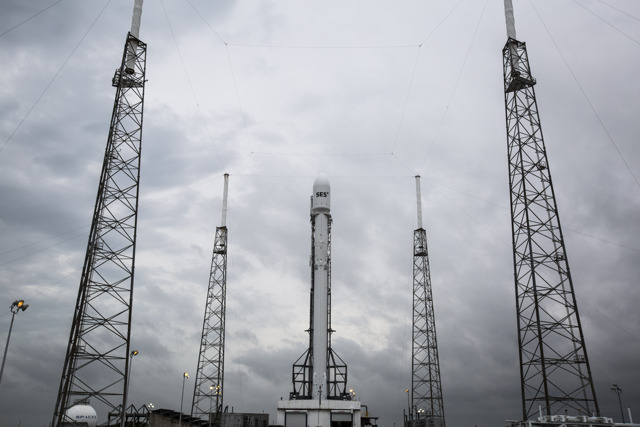
For the second day in a row, SpaceX has scrubbed the launch of the SES-9 commercial communications satellite — a mission that will also feature a daring attempt to land the first stage of SpaceX's Falcon 9 rocket on a ship at sea.
The two-stage Falcon 9 was supposed to blast off from Florida's Cape Canaveral Air Force Station at 6:47 p.m. EST (2347 GMT) today (Feb. 25). Less than two minutes before liftoff, however, launch controllers called a halt to the countdown, apparently because of an issue with the loading of liquid-oxygen propellant onto the Falcon 9.
"Right now, preliminary [indications are] that we were still evaluating the liquid oxygen propellant load, looking at how much time we had left in the count to finish loading the liquid oxgyen," John Insprucker, SpaceX's Falcon 9 product director, said during the company's launch webcast. "And at that time, the launch team decided that we would need to hold the countdown." [Inside SpaceX's Epic Fly-back Reusable Rocket Landing (Infographic)]
It's unclear at the moment when the next launch attempt will be, Insprucker added.
SES-9 was originally supposed to launch on Wednesday (Feb. 24), but that try was called off because of a propellant issue as well.
"Out of an abundance of caution, the team opted to hold launch for today to ensure liquid oxygen temperatures are as cold as possible in an effort to maximize performance of the vehicle," SpaceX representatives wrote in an update Wednesday, explaining that day's scrub.
When the Falcon 9 does lift off, it will carry SES-9 to geostationary transfer orbit (GTO) for the Luxembourg-based company SES.
Get the Space.com Newsletter
Breaking space news, the latest updates on rocket launches, skywatching events and more!
The Falcon 9's first stage, meanwhile, will come back to Earth and try to land softly on "Of Course I Still Love You," one of SpaceX's two "autonomous spaceport drone ships," which will be parked in the Atlantic Ocean off the Florida coast.
SpaceX has tried this bold move three times before — in January 2015, April 2015 and January 2016 — and nearly succeeded on each occasion: The Falcon 9 first stage managed to hit its target but ended up toppling over and exploding on the ship's deck.
SpaceX has landed a Falcon 9 on terra firma, pulling off the feat in December 2015 at Cape Canaveral. These attempts are all part of SpaceX's effort to develop fully and rapidly reusable rockets, technology that company founder and CEO Elon Musk says could slash the cost of spaceflight by a factor of 100.
Follow Mike Wall on Twitter @michaeldwall and Google+. Follow us @Spacedotcom, Facebook or Google+. Originally published on Space.com.
Join our Space Forums to keep talking space on the latest missions, night sky and more! And if you have a news tip, correction or comment, let us know at: community@space.com.

Michael Wall is a Senior Space Writer with Space.com and joined the team in 2010. He primarily covers exoplanets, spaceflight and military space, but has been known to dabble in the space art beat. His book about the search for alien life, "Out There," was published on Nov. 13, 2018. Before becoming a science writer, Michael worked as a herpetologist and wildlife biologist. He has a Ph.D. in evolutionary biology from the University of Sydney, Australia, a bachelor's degree from the University of Arizona, and a graduate certificate in science writing from the University of California, Santa Cruz. To find out what his latest project is, you can follow Michael on Twitter.









